| Bertie Formation | |
|---|---|
| Stratigraphic range: Pridoli (Cayugan Series) ~ | |
| Type | Geological group |
| Unit of | Cayugan Series |
| Sub-units | Falkirk (dolomite), Scajaquada (shale) and Williamsville (dolomite) - Western New York Fiddlers Green (dolomite), Forge Hollow (shale) and Oxbow (dolomite) - Central New York |
| Underlies | Bois Blanc Formation, Hederberg Group , Bass Islands Group |
| Overlies | Salina Group |
| Thickness | Up to 495 ft (151 m) |
| Lithology | |
| Primary | Dolomite, Shale |
| Other | Shale |
| Location | |
| Coordinates | 42°54′N 78°54′W / 42.9°N 78.9°W |
| Approximate paleocoordinates | 30°18′S 40°48′W / 30.3°S 40.8°W |
| Region | Ontario New York |
| Country | |
| Extent | Appalachian Basin |
| Type section | |
| Named for | Bertie, Ontario |
| Named by | Chapman |
| Year defined | 1864 |
 Bertie Formation (the United States)  Bertie Formation (New York) | |
The Bertie Group or Bertie Limestone, also referred to as the Bertie Dolomite and the Bertie Formation, is an upper Silurian (Pridoli, or Cayugan) geologic group and Lagerstätte in southern Ontario, Canada, and western New York State, United States. Details of the type locality and of stratigraphic nomenclature for this unit as used by the U.S. Geological Survey are available on-line at the National Geologic Map Database.[1] The formation comprises dolomites, limestones and shales and reaches a thickness of 495 feet (151 m) in the subsurface, while in outcrop the group can be 60 feet (18 m) thick.
The group represents the uppermost unit of the Cayugan Series and the youngest Silurian unit in Ontario. The group overlies the Salina Group and is conformably overlain by the Devonian Bois Blanc Formation in Ontario and Onondaga Limestone in New York.
Two formations within the Bertie Group, the Fiddler's Green and Williamsville, are considered Konservat-Lagerstätten; geologic units that contain a unique and typically soft-bodied fauna. These formations have produced thousands of Silurian eurypterids (sea scorpions) as well as early scorpion Proscorpius osborni, xiphosurans, primitive fossil flora, and the fish Nerepisacanthus denisoni. The excellent preservation of the many eurypterids and other taxa was the possibly result of periodic hypersaline and anoxic conditions owing to the group's position within a shallow inland sea (the Appalachian basin).
Description
The type locality for the Bertie Group is Ridgemount Quarry,[2] located west of Fort Erie on the Niagara Peninsula of Bertie, Ontario, 6 miles (9.7 km) west of Buffalo, New York,[3] after which the group is named.[4] The first author who recognized the group as a separate stratigraphic unit was Chapman in 1884.[3] In more recent years, the unit has been elevated to group status.[5][6]
Geographic extent
The Bertie Group forms the bedrock in a narrow band extending from Fort Erie, west of Buffalo, New York, through Hagersville, New Hamburg, Harriston, and Walkerton to Southampton on Lake Huron.[7] The group consists of medium- to massive-bedded aphanitic brown to grey, laminated, bituminous and burrowed dolomites,[8] with minor thin-bedded shaly dolomites.[9]
Along the outcrop area between Fort Erie and Hagersville, the thickness varies from 35 to 60 feet (11 to 18 m). It thickens to 495 feet (151 m) in the subsurface. Sanford (1969) used the term Bertie Group from Fort Erie to the vicinity of Hagersville and the term Bass Islands Formation north and west of Hagersville. The group is correlated with the Bass Islands Formation of Michigan. Bertie Group dolomite is quarried for crushed stone at Fort Erie, Port Colborne, Dunnville, Cayuga, and Hagersville.
Stratigraphy
The Bertie Group is the uppermost unit in the Cayugan Series and forms part of the Tippecanoe II sequence.[10] At its type locality, the group is subdivided into several formations.[3] In central New York, the Group is subdivided into the Fiddlers Green Dolomite, Forge Hollow Shale, and Oxbow Dolomite members, from oldest to youngest.[3] Here, the Bertie Group is overlain by the Honeoye and Chrysler formations. In New York, the Onondaga Limestone overlies the Bertie Group.[11] The group is in Ontario conformably overlain by the Middle Devonian Bois Blanc Formation.[12]
Laterally, the group is equivalent to the Bass Islands Formation and is mapped as a combined stratigraphic unit. Haynes and Parkins (1992) reported that the Bertie Group is progressively cut by the Bass Islands Formation from Dunnville to Hagersville.[8] In Pennsylvania, the Bertie Group is time-equivalent with the Keyser Formation.[13]
Fossils
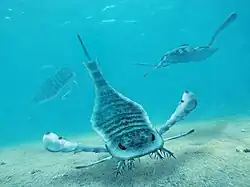

The Bertie Group Fiddler's Green and Williamsville formations are considered Konservat-Lagerstätten;[14] units characterized by rare and typically soft-bodied fauna. These formations have produced thousands of fossil eurypterids (sea scorpions) since collecting began in earnest in the mid-20th century.[15][16] Other fossils from the unit include early scorpion Proscorpius osborni, early flora, and a fossil fish; Nerepisacanthus denisoni. The excellent preservation of the many eurypterids possibly was the result of periodic hypersaline and anoxic conditions.[17]
| Group | Fossils | Member | Image | Notes |
|---|---|---|---|---|
| Fish | Nerepisacanthus denisoni | Williamsville |  | [18] |
| Eurypterids | Acutiramus macrophthalmus | Fiddlers Green Williamsville |  | [19][20] |
| A. cummingsi | Fiddlers Green | 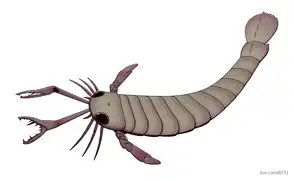 | [21] | |
| Buffalopterus pustulosus | Williamsville |  | [20][22] | |
| Carcinosoma scorpionis | Oxbow Dolomite | 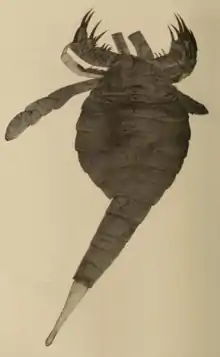 | [23] | |
| Clarkeipterus testudineus | Fiddlers Green |  | [22][24] | |
| Dolichopterus herkimerensis | Fiddlers Green |  | [22][24] | |
| D. jewetti | Fiddlers Green | [25] | ||
| D. macrocheirus | Williamsville | [20][22] | ||
| D. siluriceps | Fiddlers Green Williamsville | [20][21] | ||
| Erieopterus pustulosus | Fiddlers Green | [21] | ||
| Eurypterus dekayi | Williamsville |  | [20][26] | |
| E. laculatus | Fiddlers Green | [27] | ||
| E. lacustris | Williamsville |  | [26] | |
| E. remipes | Williamsville | _Silurian%253B_New_York_State.jpg.webp) | [20][26] | |
| Eusarcana scorpionis | Williamsville | [20] | ||
| Pterygotus cobbi | Williamsville |  | [20] | |
| P. juvensis | Fiddlers Green | [21] | ||
| Erettopterus sp. | Fiddlers Green |  | [21] | |
| E. grandis | Fiddlers Green | [21] | ||
| Rhinocarcinosoma sp. | Williamsville | 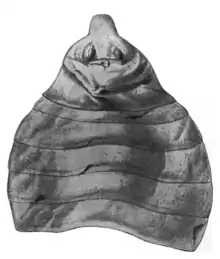 | [26] | |
| Chasmataspidid | Diploaspis praecursor | Fiddlers Green | 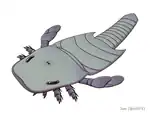 | [28] |
| Planaterga | Bunaia woodwardi | Fiddlers Green | [21] | |
| Limuloides eriensis | Fiddlers Green | [21] | ||
| Pseudoniscus clarkei, P. roosevelti | Fiddlers Green |  | [21] | |
| Arachnids | Palaeophonus osborni | Fiddlers Green |  | [29] |
| Proscorpius osborni | Fiddlers Green |  | [30] | |
| Artiopod | Naraoia bertiensis | Williamsville | [31] | |
| Machaeridians | Lepidocoleus reinhardi | Fiddlers Green | [21] | |
| Graptolites | Climacograptus ultimus | Fiddlers Green | [21] | |
| Palaeodictyota buffaloensis | Fiddlers Green | [21] | ||
| Ascograptus sp. | Fiddlers Green | [21] | ||
| Orthograptus sp. | Fiddlers Green | [21] | ||
| Non-graptolite Pterobranch | Rotaciurca superbus | Williamsville | [32] | |
| Crustaceans | Ceratiocaris acuminata, C. maccoyanus, C. praecedens | Williamsville | [33] | |
| Emmelezoe minuta | Fiddlers Green | [21] | ||
| Gonatocaris sp. | Williamsville | [20] | ||
| Cephalopods | Dawsonoceras oconnellae | Fiddlers Green | [21] | |
| Gomphoceras ruedemanni | Fiddlers Green |  | [21] | |
| Mitroceras gebhardi | Fiddlers Green | [21] | ||
| Pristeroceras timidum | Fiddlers Green | [21] | ||
| Trochoceras cf. anderdonense | Fiddlers Green | [21] | ||
| Orthoceras sp. | Fiddlers Green |  | [21] | |
| Phragmoceras sp. | Fiddlers Green | [21] | ||
| Gastropods | Loxonema bertiense | Fiddlers Green | [21] | |
| Mesocoelia gregaria | Fiddlers Green | [21] | ||
| Platyceras (Platyostoma) sp. | Fiddlers Green | [21] | ||
| Bivalves | "Hercynella" buffaloensis | Fiddlers Green | [21] | |
| Modiolopsis dubius | Fiddlers Green | [21] | ||
| Goniophora sp. | Fiddlers Green | [21] | ||
| Nuculites sp. | Fiddlers Green | [21] | ||
| Rhytimya sp. | Fiddlers Green | [21] | ||
| Ostracods | Eukloedenella umbilicata | Fiddlers Green | [21] | |
| Leperditia alta, L. scalaris | Fiddlers Green | [21] | ||
| Zygobeyrichia cf. regina | Fiddlers Green | [21] | ||
| Polychaeta | Serpulites sp. | Fiddlers Green | [21] | |
| Spirorbis sp. | Fiddlers Green | [21] | ||
| Rhynchonellata | Camarotoechia cf. andrewsi | Fiddlers Green | [21] | |
| Reticularia (Prosserella) modestoidea | Fiddlers Green | [21] | ||
| Howellella eriensis | Fiddlers Green | [21] | ||
| Whitfieldella sulcata | Fiddlers Green | [21] | ||
| Delthyris sp. | Fiddlers Green | [21] | ||
| Edrioasteroidea | Pyrgocystis batheri | Fiddlers Green | [21] | |
| Strophomenata | Schuchertella sp. | Fiddlers Green | [21] | |
| Bryozoans | Hernodia sp. | Fiddlers Green | [21] | |
| Reptaria sp. | Fiddlers Green | [21] | ||
| Stigmatella sp. | Fiddlers Green | [21] | ||
| Lingulata | Lingula semina, L. subtrigona | Fiddlers Green | [21] | |
| Orbiculoidea cf. numulus | Fiddlers Green | [21] | ||
| Scyphozoa | Metaconularia perglabra | Fiddlers Green | [21] | |
| Hydrozoa | Bertratis ciurcae | Williamsville Fiddlers Green | [34] | |
| Anthozoa | Aulocystis sp. | Fiddlers Green | [21] | |
| ?Ceratopora sp. | Fiddlers Green | [21] | ||
| Stromatoporoidea | Stromatopora constellata | Fiddlers Green | [21] | |
| Dasycladophyceae | Medusaegraptus graminiformis | Fiddlers Green | [21] | |
| Flora | Inocaulis lesqueureuxi | Williamsville | [35] | |
| Cooksonia sp. | Williamsville |  | [36] | |
| Hostinella silurica | Fiddlers Green | [37] | ||
| Cyanobacteria | Morania bertiensis | Fiddlers Green | [21] | |
| Calithamnopsis silurica | Fiddlers Green | [21] | ||
Age
The Bertie Formation is late Silurian (Pridoli, or Cayugan in the local chronologies).
Interpretations of depositional environments
The Appalachian Foreland basin was formed during the Alleghanian orogeny in the Early to Middle Ordovician. The period of mountain building led to the closure of the Iapetus and Rheic Oceans. Due to tectonic loading, the foreland basin developed in the present-day area north of the Appalachian Mountains.[38] The late Silurian climate was arid and warm; this, and the restricted and shallow nature of the inland basin, resulted in the deposition of evaporites in the Salina Group, ranging in thickness from 120 to 800 metres (390 to 2,620 ft).[39] Zones of stromatolites and thrombolites (non-laminated algal mounds) occur in several formations in the Bertie Group,[40] along with numerous desiccation cracks.[39] During the Hercynian orogeny in the Devonian, many of the Silurian sediments were eroded to the south in the Appalachians, while north of the mountains the Silurian units were preserved.[41]
The sediments of the Bertie Group were deposited on the paleosouthern side of the subsiding Algonquin Arch, flanking the northern rim of the Appalachian foreland basin of Laurentia.[14][42]
The Bertie Group was deposited in a hypersaline marine environment. The stratigraphic sections and the fossil content suggest that the group was deposited in a near-shore marine to lagoonal setting,[14] and the evaporites and casts of halite pseudomorphs, with sides of up to 30 centimetres (12 in), suggest the environment was far from normal marine; hypersalinity must have prevailed throughout most of the depositional history of the group.[29] Alternating hypersaline and brackish estuarine conditions have been recorded in the group.[14] The dolomitization of the group most probably was not primary.[43]
See also
- List of fossiliferous stratigraphic units in New York
- List of fossiliferous stratigraphic units in Ontario
- Tonoloway Formation, contemporaneous formation of Pennsylvania, Maryland, Virginia and West Virginia
- Tymochtee Dolomite, contemporaneous dolomite formation of Ohio
- Catavi Formation, contemporaneous fossiliferous formation of Bolivia
- Peel Sound Formation, contemporaneous fossiliferous formation of Nunavut, Canada
- Stony Mountain Formation, Late Ordovician Lagerstätte of Manitoba, Canada
- Lau event, Late Silurian extinction event preceding the Bertie fauna
References
- ↑ "National Geologic Map Database".
- ↑ Ridgemount Quarry South at Fossilworks.org
- 1 2 3 4 Vrazo et al., 2017, p.5
- ↑ Sun et al., 2014, p.7
- ↑ Vrazo et al., 2014, p.431
- ↑ Edwards et al., 2004, p.399
- ↑ Hewitt, 1972, p.19
- 1 2 Armstrong & Dodge, 2007, p.8
- ↑ Hewitt, 1972, p.10
- ↑ Swezey, 2002
- ↑ Rickard, 1969, p.4
- ↑ Hewitt, 1972, p.11
- ↑ Rickard, 1969, p.5
- 1 2 3 4 Burrow & Rudkin, 2014, p.1
- ↑ Lau, 2009, p.10
- ↑ Vrazo et al., 2016, p.53
- ↑ Vrazo et al., 2016, p.58
- ↑ Burrow & Rudkin, 2014, p.2
- ↑ Eurypterid-Associated Biota of the Fiddlers Green Member, Herkimer Co., New York at Fossilworks.org
- 1 2 3 4 5 6 7 8 9 Eurypterid-Associated Biota of the Williamsville Member, Buffalo, New York at Fossilworks.org
- 1 2 3 4 5 6 7 8 9 10 11 12 13 14 15 16 17 18 19 20 21 22 23 24 25 26 27 28 29 30 31 32 33 34 35 36 37 38 39 40 41 42 43 44 45 46 47 48 49 50 51 52 53 54 Bertie at Fossilworks.org
- 1 2 3 4 Lau, 2009, p.22
- ↑ Heard's Gypsum Quarry at Fossilworks.org
- 1 2 Cranes Corners at Fossilworks.org
- ↑ Jerusalem Hill at Fossilworks.org
- 1 2 3 4 Lau, 2009, p.21
- ↑ Eurypterids of the Fiddlers Green Member, Morganville, New York at Fossilworks.org
- ↑ Lamsdell, James C.; Briggs, Derek E. G. (2017). "The first diploaspidid (Chelicerata: Chasmataspidida) from North America (Silurian, Bertie Group, New York State) is the oldest species of Diploaspis". Geological Magazine. 154 (1): 175–180. doi:10.1017/S0016756816000662. ISSN 0016-7568.
- 1 2 Forge Hollow, Waterville at Fossilworks.org
- ↑ Passage Gulf at Fossilworks.org
- ↑ Caron, Jean-Bernard; Rudkin, David M.; Milliken, Stuart (2004). "A new Late Silurian (Pridolian) naraoiid (Euarthropoda: Nektaspida) from the Bertie Formation of southern Ontario, Canada—delayed fallout from the Cambrian explosion". Journal of Paleontology. 78 (6): 1138–1145. doi:10.1017/s0022336000043948. ISSN 0022-3360.
- ↑ Briggs, Derek E. G.; Mongiardino Koch, Nicolás (2023-11-06). "A Silurian pseudocolonial pterobranch". Current Biology. 33 (23): 5225–5232.e3. doi:10.1016/j.cub.2023.10.024. ISSN 0960-9822.
- ↑ Collette, Joseph H.; Hagadorn, James W. (2010). "Early Evolution of Phyllocarid Arthropods: Phylogeny and Systematics of Cambrian-Devonian Archaeostracans". Journal of Paleontology. 84 (5): 795–820. doi:10.1666/09-092.1. ISSN 0022-3360.
- ↑ Larson, Evelyn; Briggs, Derek E. G. (2023-12-01). "A hydrozoan from the eurypterid-dominated Silurian Bertie Group Lagerstätten of North America". Journal of Paleontology: 1–7. doi:10.1017/jpa.2023.62. ISSN 0022-3360.
- ↑ Edwards et al., 2004, p.405
- ↑ Edwards et al., 2004, p.401
- ↑ Bertie Formation at Fossilworks.org
- ↑ Ettensohn, 2008, p.107
- 1 2 Vrazo et al., 2016, p.49
- ↑ Brett et al., 1999, p.10
- ↑ Ettensohn, 2008, p.136
- ↑ Lau, 2009, p.24
- ↑ Vrazo et al., 2016, p.56
Bibliography
- Armstrong, Derek K., and J.E.P. Dodge. 2007. Paleozoic Geology of Southern Ontario, 1–27. Ontario Geological Survey. Accessed 2019-03-23.
- Brett, Carlton E.; William M. Goodman; Steven T. Loduca, and Denis Tetreaul. 1999. Silurian-Early Devonian sequence stratigraphy, events, and paleoenvironments of western New York and Ontario, Canada, 1–58. NYSGA. Accessed 2019-03-23.
- Burrow, Carole J., and David Rudkin. 2014. Oldest Near-Complete Acanthodian: The First Vertebrate from the Silurian Bertie Formation Konservat-Lagersta¨tte, Ontario. PLoS ONE 9. 1–7. Accessed 2019-03-23.
- Edwards, D.; H.P. Banks; S.J. Ciurca, and R.S. Laub. 2004. New Silurian cooksonias from dolostones of north-eastern North America. Botanical Journal of the Linnean Society 146. 399–413. .
- Ettensohn, Frank R. 2008. The Appalachian Foreland Basin in Eastern United States. K.J. Hsü: Sedimentary Basins of the World, Vol 5, The Sedimentary Basins of the United States and Canada 5. 105–179. Accessed 2019-03-23.
- Hewitt, D.H. 1972. Paleozoic Geology of Southern Ontario, 1–19. Ontario Division of Mines. Accessed 2019-03-23.
- Lau, Kimberly. 2009. Paleoecology and Paleobiogeography of the New York Appalachian Basin Eurypterids (BSc. thesis), 1–48. Yale University. Accessed 2019-03-23. Archived 2018-02-28 at the Wayback Machine
- Rickard, Lawrence V. 1969. Stratigraphy of the Upper Silurian Salina Group New York, Pennsylvania, Ohio, Ontario, 1–77. New York State Museum and Science Service. Accessed 2019-03-23.
- Sun, S.; F.R. Brunton, and J. Jin. 2014. Sequence Stratigraphic Architecture and Bedrock Aquifers of Upper Silurian to Middle Devonian Strata, Southwestern Ontario, 1–15. Ontario Geological Survey, Open File Report 6300. Accessed 2019-03-23.
- Swezey, Christopher S. 2002. Regional Stratigraphy and Petroleum Systems of the Appalachian Basin, North America, 1. USGS. Accessed 2019-03-23.
- Treesh, Michael. 1972. Sedimentology and Stratigraphy of the Salina Group (upper Silurian) in East-central New York, 1–26. Rensselaer Polytechnic Institute. Accessed 2019-03-23.
- Vrazo, Matthew B.; Carlton E. Brett, and Samuel J. Ciurca Jr. 2016. Buried or brined? Eurypterids and evaporites in the Silurian Appalachian basin. Palaeogeography, Palaeoclimatology, Palaeoecology 444. 48–59. Accessed 2019-03-23.
- Vrazo, Matthew B.; Jeffrey M. Trop, and Carlton E. Brett. 2014. A new eurypterid Lagerstätte from the Upper Silurian of Pennsylvania. PALAIOS 29. 431–448. Accessed 2019-03-23.

